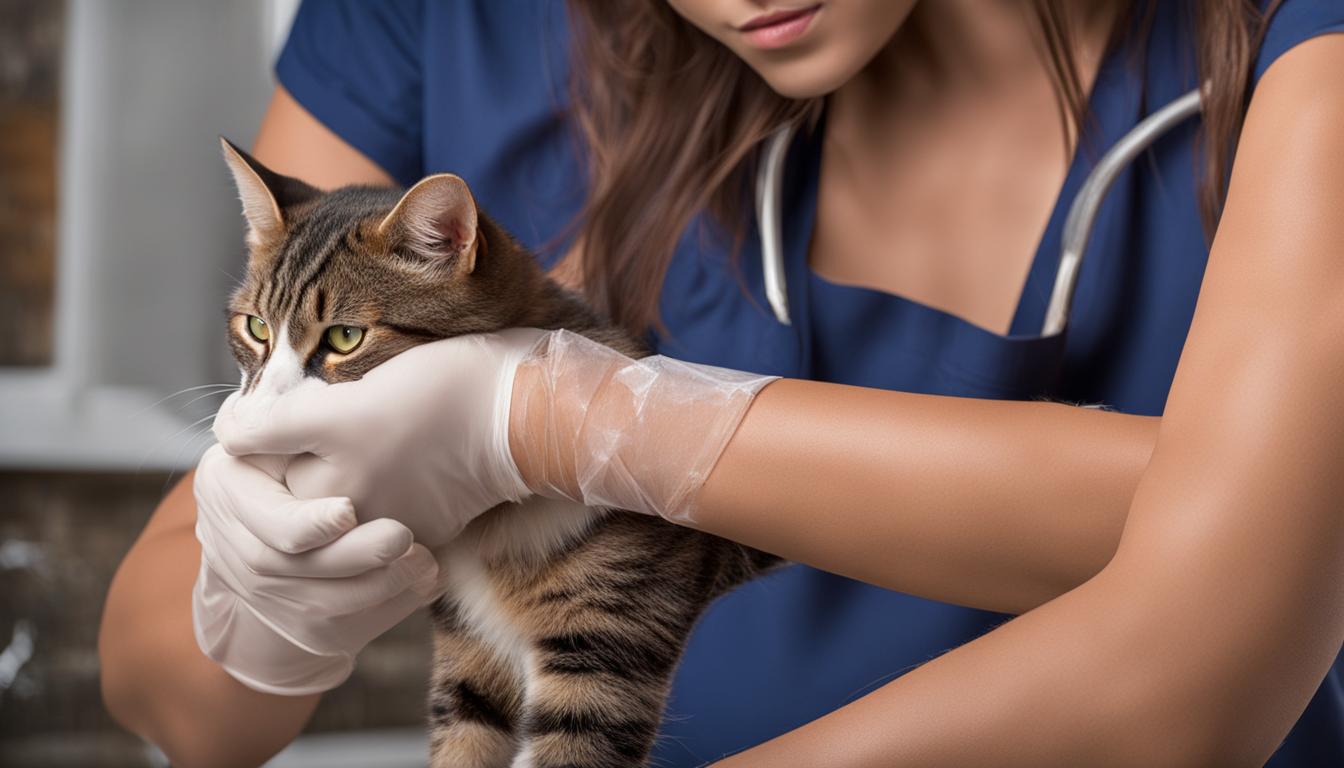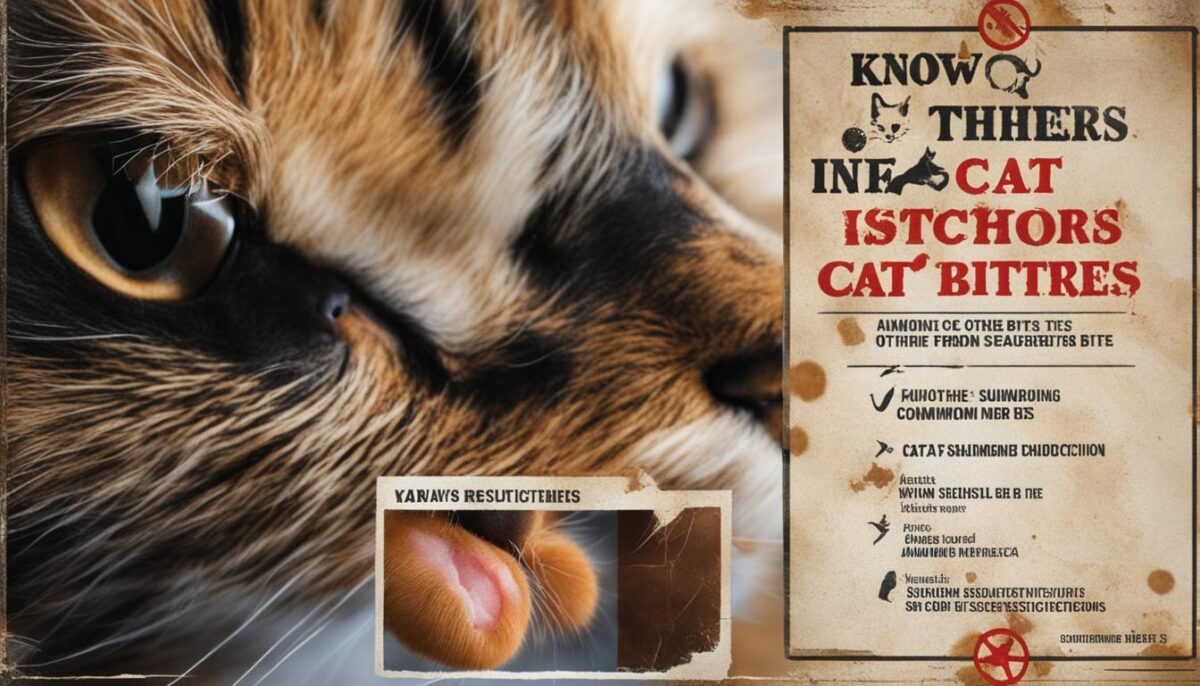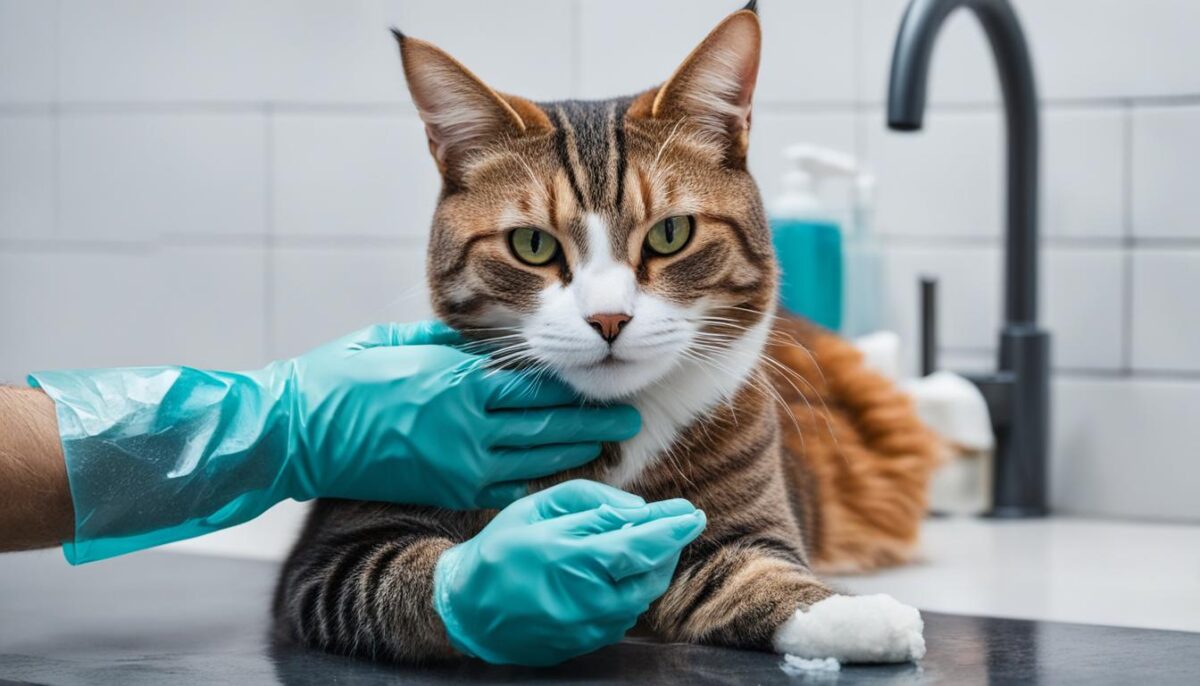Hey there! Did you know that a little scratch from a cat could make you think about rabies? It sure can! Even though getting rabies from a cat scratch is pretty rare, it’s something you should be aware of. Most of the time, people get rabies from an animal’s bite, not a scratch. So, what is rabies? It’s a bad virus that messes with your body’s nerves. It can make you feel confused, afraid of water, and will make you really sick, like you have a bad flu.
Now, cats and dogs can get shots to not get rabies. That helps keep them and you safe. If a cat does scratch you, you should wash the spot right away with water and soap. This helps you not get sick. And watch out for signs that something’s not right, like redness or swelling. Always be extra safe around animals you don’t know, and ask a doctor for help if you get bitten or scratched.
Key Takeaways
- Rabies from a cat scratch is very rare, but still possible.
- Clean any scratches with soap and water quickly to help prevent rabies.
- Vaccinate your pets to protect them from getting rabies.
- Watch for signs of infection, like swelling or red bumps.
- If you’re ever worried about a scratch, it’s smart to talk to a doctor.
Understanding Rabies and Its Transmission
Have you ever wondered how rabies spreads? Rabies causes a lot of worry, but knowing how it moves from one living thing to another can help keep you safe. Now, let’s look into how this sneaky virus gets around.
What Is Rabies and How Is It Spread?
Rabies is a sickness that can make both animals and people really ill. It likes to attack the brain and nerves, which can cause some pretty scary problems. The rabies virus usually gets passed on through animal bites. That’s when an infected animal’s spit gets into someone else’s body and passes on the virus.
Rabies Transmission: Bites vs. Scratches
Even though getting rabies from cat scratches is not common, it can happen. This is because if an infected cat has the rabies virus in its saliva, and that saliva finds its way into a scratch, the virus can spread to another person. But remember, this doesn’t happen very often, so don’t be too worried!
The Role of Cat Saliva in Rabies Infection
Cat saliva can sometimes have the rabies virus in it. If a cat has rabies and it licks its claws before scratching someone, the saliva with the virus could get into the scratch. So, it’s important to keep your cats’ shots for rabies up-to-date. It’s the best way to stop this infection.
Rabies spread happens more with wild animals like bats and raccoons than with pets like cats and dogs in the United States. But keeping all pets’ vaccinations fresh and current is the number one defense against the disease. So, make sure your furry friends stay up-to-date with their shots, and you can feel safer knowing you’re doing a great job in keeping everyone healthy!
Can You Get Rabies from a Cat Scratch?
Have you heard that getting scratched by a cat can be risky? It’s true, but getting rabies from a scratch is pretty rare. Most folks get rabies from bites, not scratches. In the United States, rabies safety is important, and cats don’t often carry rabies. Since 1975, only one person has gotten rabies from a cat scratch. That’s really uncommon!
If you’re ever scratched by a cat, especially one you don’t know, keep an eye on it. If the cat seems sick or you’re worried, it’s smart to talk to a doctor just to be safe. Remember, the best way to lower your rabies infection risk is to vaccinate your pets. That’s how you help stop rabies transmission before it can start.
| If a cat scratches you: | What to do: |
|---|---|
| It’s a pet cat you know | Clean the scratch, watch for changes. If it looks weird, see a doctor. |
| It’s a cat you don’t know | Say hi to your doctor, mainly if the cat acts sick or strange. |
| Your cat’s up-to-date on vaccines | Great! Keep making sure they stay vaccinated. |
| Your cat’s not vaccinated or you’re not sure | Check with a vet about vaccines and see a doctor if you’re scratched. |
Staying safe from rabies means caring for scratches the right way and keeping your furry friends’ shots up to date. Talk with a grown-up if you think a cat scratch is bad or if you have questions about rabies. They can help make sure you and your pets are safe!
Other Infections from Cat Scratches and Bites
Cat friends are fun! But sometimes, when they scratch or bite, they might give us an “ouch” and a little more. Yes, we talked about rabies, but there are other icky things like cat-scratch disease and some bacterial infections from cats. Don’t worry, we’ll learn what they are and how to make the ouchies better!
Cat-Scratch Disease: Symptoms and Causes
Cat-scratch disease comes from a sneaky germ named Bartonella henselae, and it’s often the little kitties or cats we don’t know that can spread it. After a scratch, you might see a red bump or feel your lymph nodes get big and ouchy like balloons. Not fun!
Bacterial Infections: Understanding the Risks of MRSA and More
Got a cut from a cat bite? We need to talk about some germs like MRSA, Pasteurella, and Streptococcus. These can sneak into the cuts and make us feel pretty blah with red skin or a fever. So, let’s keep clean and check with a grown-up or a doctor if the bite looks angry.
Preventing and Treating Infections from Cat Bites
If a cat’s tooth gets you, start by washing it super well with soap and water. If it starts looking red or making you feel bleh, then a doctor can help with cat bite treatment. They know just what to do to kick those germs out!
Remember, friends, even though cat scratches and bites can hurt and sometimes make us sick, we can do a lot to make sure we stay healthy and keep playing with our fuzzy buddies. 😺
| If this happens: | Then you might see: | What to do: |
|---|---|---|
| Cat scratches you | Red bump, swollen lymph nodes | Clean it and watch if it gets puffy or ouchy |
| Cat bites you | Red skin, fever, feels super ouchy | Clean with soap/water. Doctor time if feeling yucky! |
Cleaning and Caring for Cat Scratches
When a cat scratches you, remember to stay calm. It’s important to clean the scratch right away to help stop germs. Let’s make sure you know just what to do to take good care of it.
First Aid for Cat Scratches and Bites
It’s pretty simple to help your scratch or bite. First, wash it with soap and water for about five minutes. Next, put a clean bandage on it to keep it safe from dirt. Check the scratch each day to make sure it doesn’t look red, feel more painful, or start to swell up. If it does, you might need some help from a doctor.
When to Seek Medical Attention for a Cat Scratch
If your scratch gets red, hurts more, or starts to puff up, it’s time to see a doctor. Also, if you get a fever, that’s a sign to get some help. And if a cat you don’t know well gives you a scratch, it’s good to check with a doctor, just to be safe.
| Signs | First Aid at Home | See a Doctor? |
|---|---|---|
| Redness, pain, swelling | Clean with soap, apply bandage | Yes, if it gets worse |
| Scratch from an unknown cat | Clean with soap, apply bandage | Yes, to be safe |
| Fever appears | Rest and drink fluids | Yes, to prevent sickness |
Rabies in the United States: Prevalence and Vaccination
Did you know that rabies isn’t very common in pets in the United States anymore? That’s because lots of pets like dogs and cats are getting their vaccination shots. This is great for pet health and keeps pets and people safe. Even though it’s rare for pets to get rabies now, wild animals can still carry the virus. It’s important to know which animals might have rabies, so always check with someone who knows, like your doctor or local health department, especially if an animal bites you.
When families go to places where pets might not get as many shots to protect them from rabies, it’s a good idea to get the rabies vaccine before you go on your trip. That way, you can help stop rabies from spreading. Keeping up with your pet’s vaccinations is a huge part of rabies control. It’s just like when you get your own shots to stay healthy. By doing this, you’re looking out for everyone’s health, both for pets and people!
Here’s some interesting information about rabies prevalence and vaccination rates:
- Most of the rabies in the U.S. comes from wild animals like bats and raccoons.
- Very few cats and dogs get rabies each year because they get their shots.
- Every state has different rules about which pets need rabies shots, so it’s good to know these rules where you live.
Remember, the best way to make sure you and your pets stay healthy is to keep up with your shots. Vaccines are like super shields that protect you from getting sick!
Recognizing the Signs of Rabies in Cats and Humans
Did you know that both cats and people can show rabies signs? When someone gets rabies, they may feel hot because of a fever or have a bad headache. They might also feel really tired. These are some of the initial symptoms of rabies. It’s important to pay attention to these early signs because the sickness can get very serious fast.
Initial Symptoms of Rabies in Cats and Humans
At the start, you might notice strange feelings where the bite or scratch is. This happens in the early stages of rabies. Later, people might get mixed-up in their thinking, drool a lot, or become scared of water. If cats get rabies, they may act out of the ordinary, like being too scared or way too friendly.
Progression and Stages of Rabies Infection
The rabies stages can be serious. If a cat or a person doesn’t get help, they can have very bad problems like shaking a lot, which is called a seizure. Sometimes, they can’t even survive the late infection progression stage of rabies. This is why it’s so very important to go to the doctor or a vet quickly if you think you or your cat might have been around rabies.
Always keep an eye out for how rabies can start and get worse. Remember, there’s no cure after it gets bad, so fast help is key.
Conclusion
It’s not common to get rabies from a cat scratch. You are much more likely to run into rabies from wild animals like bats or sometimes dogs in other countries. But it’s always good to be careful around all animals, even pets. We all love our furry friends, and keeping them safe keeps you safe too. Make sure your pets have their shots to prevent rabies. If they are up-to-date on their vaccines, they are less likely to get sick and that means you are safer.
If you ever get a scratch from a cat, clean it right away. Use soap and water and scrub the spot where you got scratched for a bit. If you start to feel weird, like if the scratch gets red or puffy, let your doctor know. They can help make sure everything is okay. Always remember to be extra watchful and stay away from animals you do not know. This keeps you from getting sick.
By understanding the risks of rabies and how to be careful with cat scratches, you can take good care of yourself and your pets. Remember, pet health safety is important. Keeping an eye out and cleaning wounds can help a lot in preventing rabies. So stay smart about your pet’s health and your own. Keep safe by learning about rabies and by being watchful with cat scratches. By doing these things, you can help make sure you and your pets stay happy and healthy.
FAQ
Can you get rabies from a cat scratch?
It’s possible, but very unlikely. Rabies is more commonly transmitted through animal bites than scratches. If a cat’s saliva containing the rabies virus comes into contact with your skin via a scratch, there is a risk. That said, such cases are exceedingly rare. Always clean any scratches immediately and consult a doctor if you’re concerned.
What is rabies and how is it transmitted?
Rabies is a virus that attacks the central nervous system and can be fatal. It’s typically spread through the saliva of infected animals, primarily via bites. Transmission through scratches is rare and usually would involve infected saliva in the wound.
Are cat scratches more dangerous than dog bites when it comes to rabies?
No, in fact, the opposite is true. Dog bites are a more common source of rabies transmission than cat scratches in regions where dogs are not regularly vaccinated against rabies. Cat scratches pose minimal risk for rabies transmission but can result in other infections like cat-scratch disease.
What are the symptoms of cat-scratch disease, and what causes it?
Cat-scratch disease is a bacterial infection caused by Bartonella henselae. Symptoms may include a red bump at the site of the scratch, fever, fatigue, and swollen lymph nodes. It’s most often spread by kittens or feral cats when they scratch or bite.
What kinds of infections can you get from cat bites, and how serious are they?
Cat bites can lead to bacterial infections such as Pasteurella, Streptococcus, and MRSA. These infections can develop rapidly due to deep puncture wounds from a cat’s teeth and may require antibiotic treatment. Always clean bite wounds thoroughly and seek medical attention if you notice signs of infection.
How should I clean and care for a cat scratch or bite?
Immediately rinse the wound with soap and running water for at least five minutes, then cover it with sterile gauze or a bandage. Watch for signs of infection, such as increased redness, swelling, or fever. If these occur, or if the wound is deep, seek medical attention promptly.
When should you seek medical attention after being scratched by a cat?
Seek medical attention if the scratch is deep, if it was inflicted by a stray or unknown cat, if there are signs of infection, or if you haven’t had a tetanus shot in the past 5 years. Also, consult your doctor if the cat has an unknown vaccination history, especially for rabies.
What is the prevalence of rabies in the United States, and how important is vaccination?
Rabies is less common in the U.S. today thanks to widespread pet vaccination practices. It is still mostly spread by wild animals, with a very small number of domestic animals, including cats, contracting the disease annually. Keeping your pets vaccinated is crucial in preventing the spread of rabies.
What are the initial symptoms of rabies in cats and humans?
Early signs of rabies in both can include fever, general weakness, and discomfort. There may also be a tingling sensation around the site of the bite or scratch. Since rabies progresses quickly after symptoms appear and can be fatal, immediate medical attention is vital if you suspect exposure.
How does a rabies infection progress and what are the stages?
Following the initial symptoms, rabies progresses to neurological symptoms such as confusion, agitation, and hallucinations. Hydrophobia (fear of water) and hypersalivation may develop. The disease then progresses to the paralytic stage, eventually leading to coma and death if untreated.


